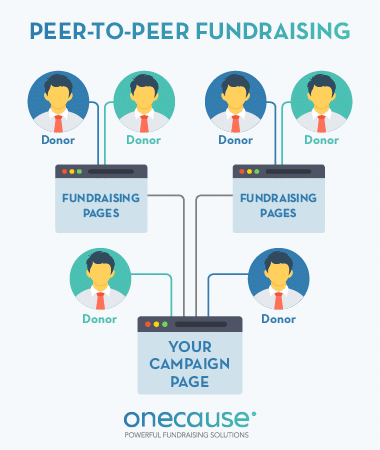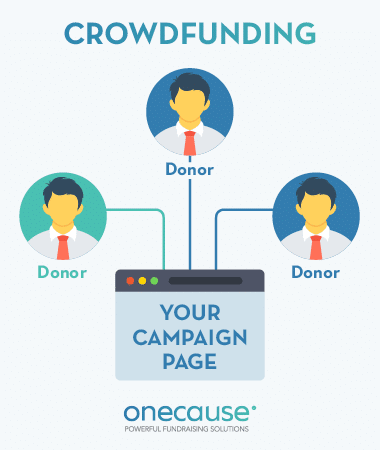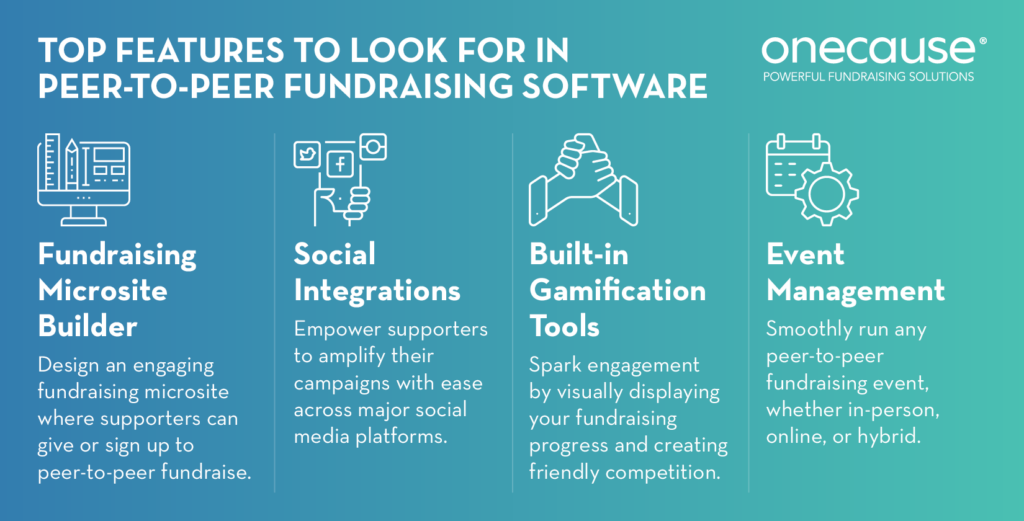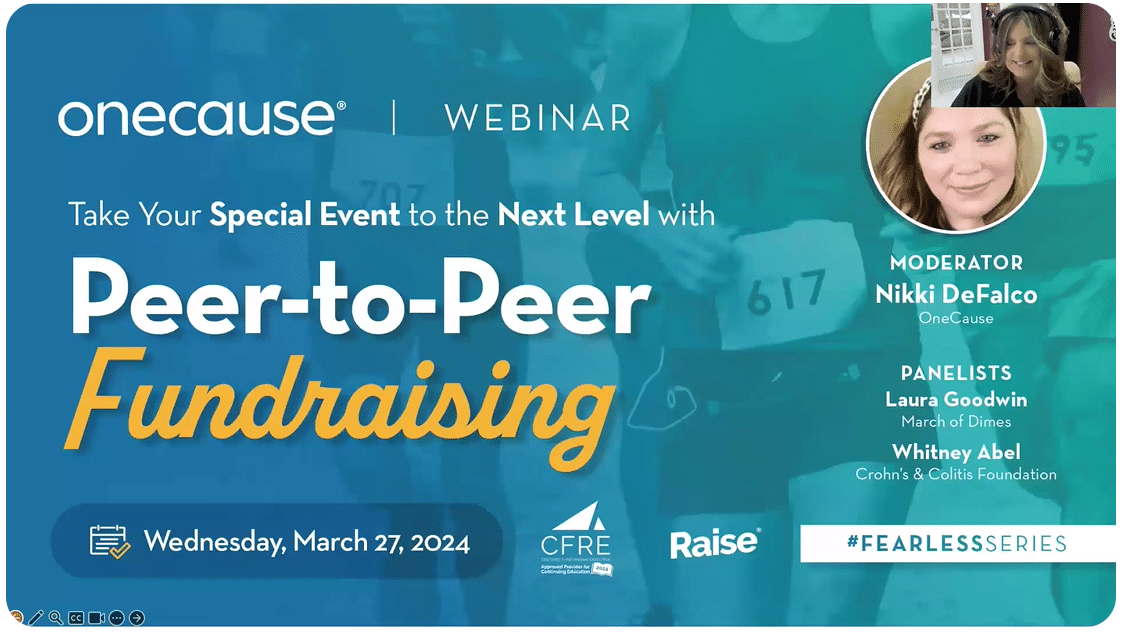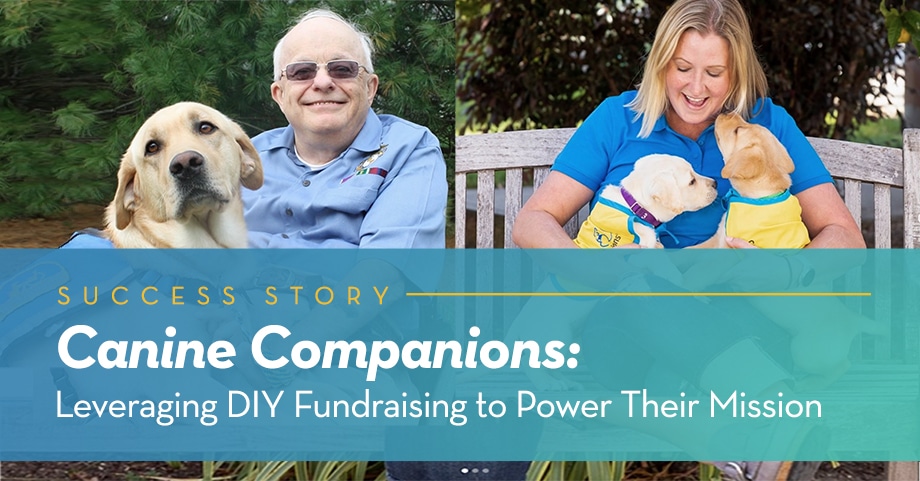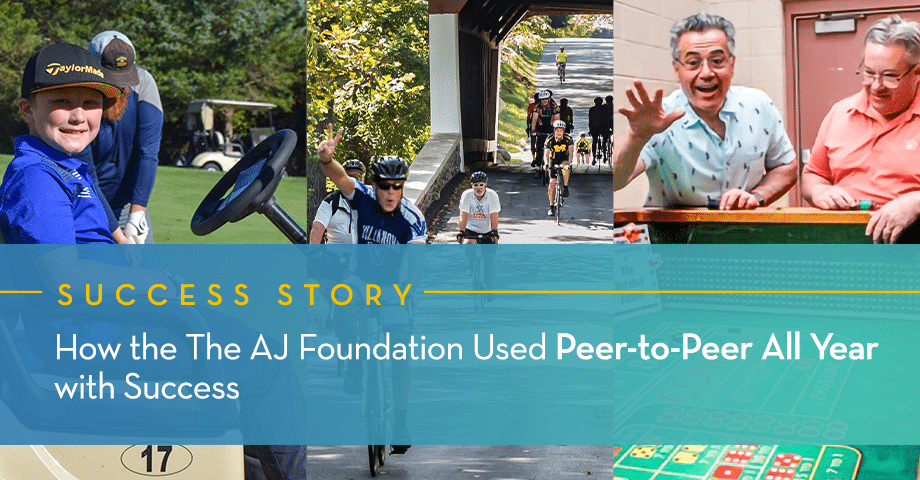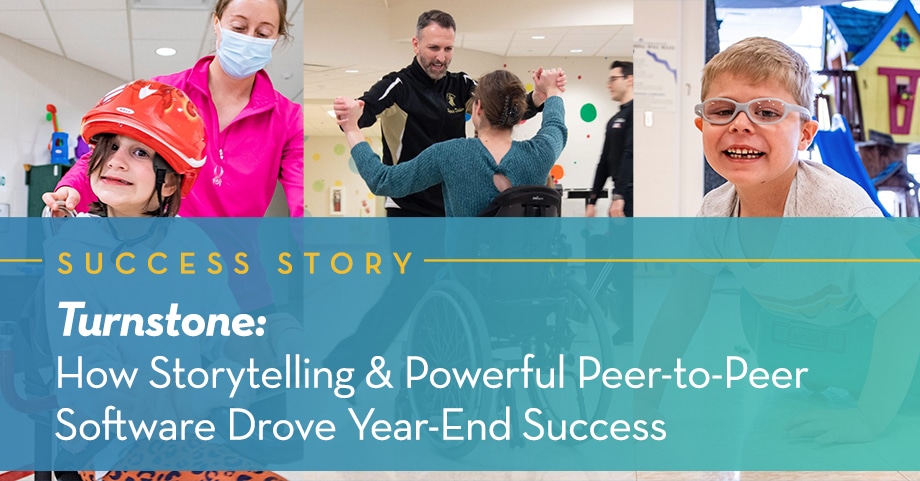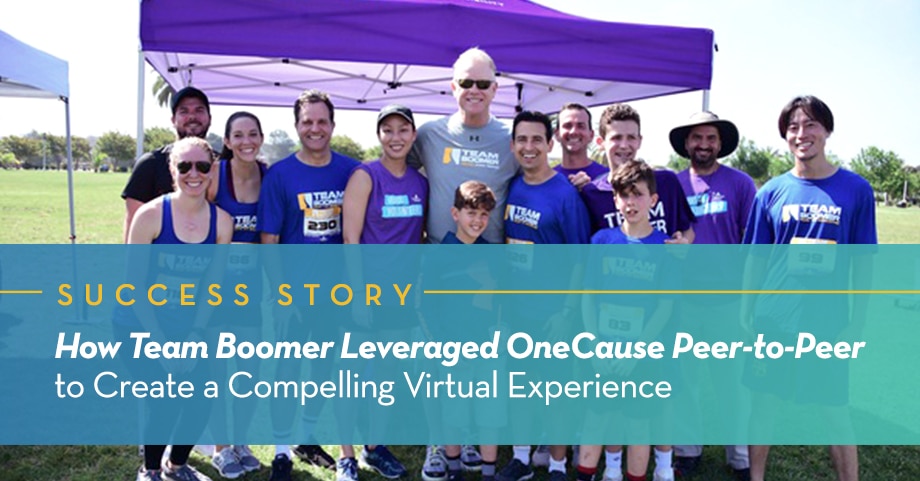Unlocking the Secret to Peer-to-Peer Fundraising Success
We trust our family and friends, so when they recommend a plumber, share their trusted real estate agent’s name with us, or tell us about the best new restaurant in town, we’re more likely to try them out.
Those same word-of-mouth recommendations pay off for nonprofits. When giving to an event or campaign, 58% of donors say they heard about the opportunity from a friend, family member or colleague.
Having donors raise money on behalf of your nonprofit, also called peer-to-peer fundraising, can be incredibly impactful in helping you reach more donors and raise more money.
While many nonprofits understand the impact and flexibility that peer-to-peer fundraising brings, implementation can fall short. The OneCause 2025 Fundraising Outlook Report reveals nonprofits felt their run/walk/ride and DIY peer-to-peer efforts could be better (31% and 45% respectively). Another 10% said their runs, walks and rides weren’t successful at all, while 13% said they had no success with DIY P2P campaigns.
Let’s bridge that gap and set your mission up to succeed with peer-to-peer fundraising.
What is Peer-to-Peer Fundraising?
Peer-to-peer fundraising, also called P2P, social fundraising, or team fundraising, is an online fundraising technique in which individual supporters or ambassadors fundraise on behalf of a larger cause or nonprofit organization. These volunteer fundraisers promote the campaign to their networks of friends and family online.
The peer-to-peer fundraising structure is different from more traditional campaigns because it’s decentralized and supporter-driven. This allows the organization to reach much larger audiences and boost its online visibility organically.
Ready to tap into the power of peer-to-peer fundraising? We’ll dig into the extensive benefits and examples of successful campaigns below, but for now, let’s start with the basics.
Peer-to-Peer Fundraising FAQ
What’s the difference between crowdfunding and peer-to-peer fundraising?
You’re probably already familiar with a similar but quite distinct form of online fundraising called crowdfunding. Both crowdfunding and P2P fundraising rely on the power of online networks to raise support and awareness but with these key differences:
Peer-to-Peer Fundraising
Peer-to-peer fundraising involves supporters who fundraise independently on your organization’s behalf using individual donation pages.
Nonprofits use specialized peer-to-peer fundraising software to equip supporters with the tools to raise funds on their own, with all donations going back to the organization.
Crowdfunding
In a crowdfunding campaign, both the organization and individuals use a single crowdfunding page to promote the campaign online.
Anyone can set up a personal crowdfunding campaign for any project, cause, or need they choose and keep the money raised, minus any fees.
In many cases, the broader reach of a peer-to-peer fundraising campaign makes it the smarter online fundraising strategy, while very specific, smaller-scale projects could be better suited to a crowdfunding campaign. P2P fundraising also makes it easier to actively build relationships with new supporters.
Check out our Crowdfunding vs. Peer-to-Peer Explainer to learn more
What are the types of peer-to-peer fundraising?
Peer-to-peer fundraising is an extremely flexible approach and is regularly used by nonprofits to conduct:
When you master the best practices of peer-to-peer fundraising and equip your team with the right tools, you open up all kinds of exciting new engagement opportunities.
What peer-to-peer fundraising tools do I need?
Start with the right peer-to-peer fundraising software, which enables you (and your supporters) to create individual donation pages. This will be the foundation of your campaigns, as it helps with the planning process, makes donations easy, and provides useful campaign insights.
You’ll also need an active social media presence and email capabilities to help promote your campaign. Depending on the context of your campaign, you may also need event planning tools and an ambassador recruitment strategy.
Check out our reviews of the top P2P solutions for nonprofits
Benefits of Peer-to-Peer Fundraising
There are several major benefits of peer-to-peer fundraising for both your nonprofit and your donors. If you’re on the fence about planning a P2P campaign, here are a few top benefits:
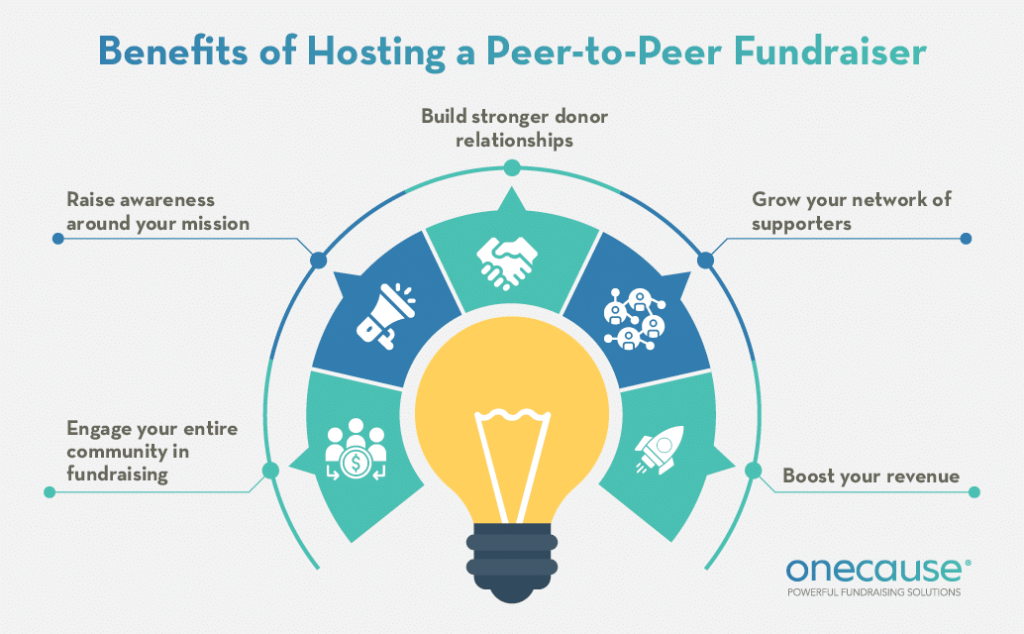
- Engage your entire community in fundraising with an accessible, decentralized, organic P2P approach
- Raise awareness around your cause through the power of your supporters’ networks
- Build stronger donor connections as you empower them to directly push your campaign forward
- Grow your network of supporters through increased exposure and social proof
- Increase your total event earnings through the combination of boosts to awareness, engagement, and acquisition
Personalized involvement and opportunities to share their passion help motivate supporters. As a result, P2P campaigns can foster long-term benefits by establishing valuable, long-lasting relationships with supporters.
How to Host a Peer-to-Peer Fundraiser: 8 Steps
Peer-to-peer fundraising is extremely flexible, so you can customize your campaign to meet your nonprofit’s mission, culture, and donor base. However, every campaign follows these core steps:
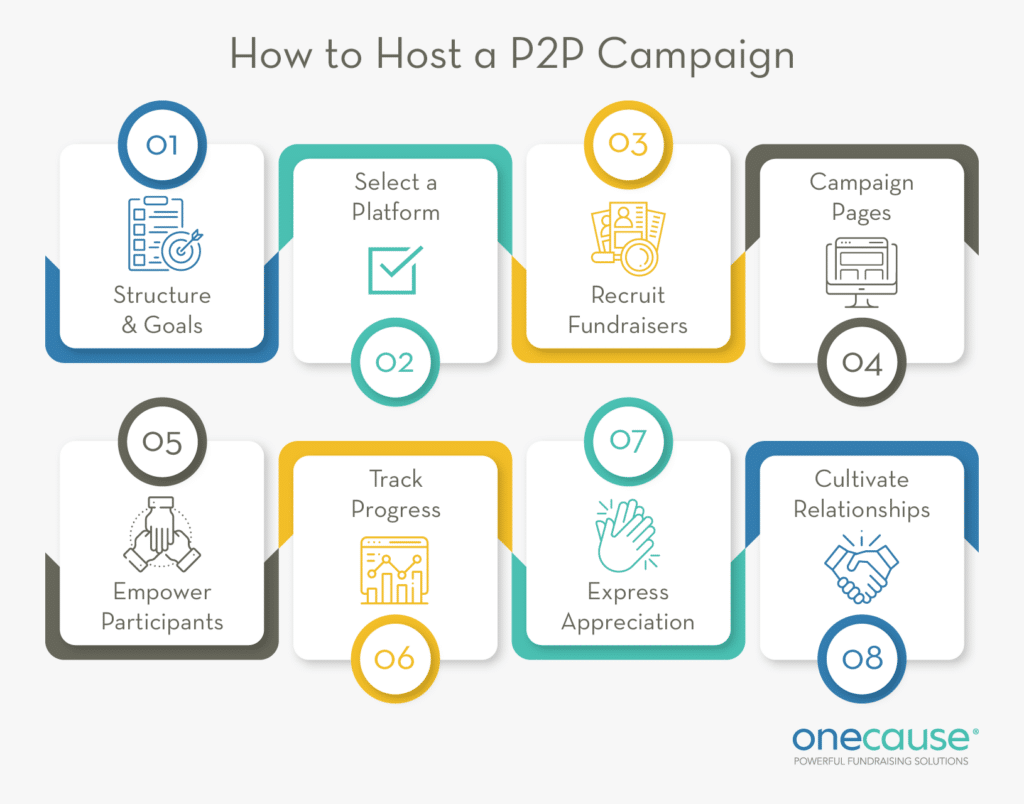
Step 1: Decide on your peer-to-peer campaign’s structure and goals
Determine how you want your campaign to work and define your fundraising goals. Answer these key questions to determine key guidelines for your campaign:
- How much do you want to raise?
- What’s your budget?
- What project or program will the campaign fund?
- What’s the timeframe or deadline for the campaign?
- Will you tie your fundraiser to an in-person, virtual, or hybrid event?
- Will you recruit ambassadors or allow anyone to launch their own giving page?
Based on your needs and the context of the campaign, determine which format will be the best fit for your nonprofit.
Step 2: Select your peer-to-peer fundraising software
The right fundraising software is essential for any peer-to-peer campaign, as it allows you and your supporters to set up fundraising pages and collect donations. Look for an option that fits your budget but is robust enough to grow alongside your organization. The top features to prioritize in P2P software include:
- Microsite building tools to create a digital hub for the campaign and for supporters to easily sign up and launch pages of their own.
- Social integrations to power your campaign’s reach and make the promotion process truly effortless for supporters.
- Gamification tools to track progress, generate a little competition, and quickly recognize top fundraisers.
- Event management features to support an organized, engaging experience from check-in to check-out.
Looking for an all-in-one peer-to-peer fundraising suite that grows with your nonprofit, its goals, and events? Look no further than OneCause — our software makes launching campaigns a breeze for your organization and promotes a seamless giving experience for your supporters.
Remember that ease is the #1 motivator for donors! Our robust set of fundraising and event features are designed to support stellar donor journeys from start to finish.
Step 3: Recruit your P2P fundraisers
Whether you allow anyone to fundraise for your campaign or recruit ambassadors more intentionally, you’ll need to actively promote the fundraiser to your social donors via email and social media so they’re aware of the opportunity.
The exact approach will vary based on the type of campaign and event(s) you’re hosting, but it’s always a good idea to get started early.
We recommend being prepared with your core campaign web page or microsite (see Step 4), plus a downloadable campaign guide full of quick talking points, examples of social media posts, and other details to share with volunteers to help them effectively represent your organization.
Step 4: Set up your campaign page(s)
Your campaign will be structured around a main campaign page, with your supporters launching their individual participant pages to secure donations online. Use these pages to tell a compelling, exciting story about why your campaign matters, and encourage your fundraisers to customize their pages to explain why they love your cause.
There are several ways you can set your fundraisers up for success. Give them example impact statements and facts about how donations make a difference. Create a complete example fundraising page to give volunteers an example to follow.
Again, the right P2P software will be critical to ensure this step goes smoothly and leaves fundraisers with a lasting positive impression.
Step 5: Empower your peer-to-peer fundraising participants
After supporters create their web pages, you should still take steps to ensure your fundraisers are well-equipped to bring in donations and raise awareness for your cause.
Have a plan to actively support them, and provide materials that explain your campaign, goals, and impact. Create a digital library of graphics, facts, and examples for them to use in social media posts. Designate a primary point of contact at your organization to serve as the main support for P2P fundraisers and ambassadors, and create a schedule for this individual to:
- Check on volunteer progress
- Post updates and leaderboard stats
- Reach out to offer support to volunteers if needed
- Recognize and thank top fundraisers in real time
Step 6: Keep up with your campaign.
You’ll also need to track your campaign’s overall progress toward its fundraising goal via your peer-to-peer fundraising software.
Check in frequently and make adjustments or provide extra support to your volunteers as needed. Jump in to give the campaign extra promotions directly from your organization to jolt more engagement and visibility.
Depending on the timing of your campaign plan, you may need to be actively working on associated event logistics so it’s ready to launch when the time comes. These often occur at the end of campaigns, but be mindful of your unique timeframe and get started on the event planning process as early as possible.
Step 7: Express supporter appreciation
Throughout and after the campaign, thank everyone whose hard work made it a success. This means:
- Recognizing fundraisers throughout the campaign and shouting out top performers
- Sending thank-you messages (and maybe small gifts) to all volunteers after the campaign
- Using your software to send automated thank-you messages to all campaign donors
- Following up with extra thanks to campaign donors, perhaps above a certain giving threshold
- Sending or posting post-campaign reports and announcements about your community’s accomplishments and the impact of that success
Keep track of your outreach and any extra engagement it generates, as this can help a lot with the next step of securing long-term support.
Step 8: Create a new donor cultivation strategy
Peer-to-peer fundraising campaigns are so impactful because they generate a ton of engagement and help you reach new audiences.
To truly make the most of this increased visibility, you need a plan to engage and retain new supporters.
Develop guidelines for staying in touch with all new campaign donors by plugging them into your nonprofit’s regular communications. Continued outreach, mission updates, and event invites will further build your relationship.
And for new high-value donors, take it a step further. Personally reach out to offer your thanks, and add them to a more targeted outreach stream geared toward your mid-level and major donors. Conduct a quick prospect research screening to identify significant opportunities, and follow your organization’s normal cultivation process from there.
Best Practices for Peer-to-Peer Fundraising Campaigns
Next, let’s walk through a few essential best practices that can help any peer-to-peer fundraising campaign succeed, starting with our top three tips:
Use dedicated peer-to-peer fundraising software.
P2P fundraising campaigns can have a lot of moving parts. You’ll need an effective way to plan the campaign, provide a seamless giving experience, and track both your overall performance and the performance of individual fundraisers. Dedicated software will give you the top-down, detailed views you need, plus make it easy for your supporters to amplify your efforts.
Actively recruit ambassadors for your campaign.
DIY-style campaigns in which any supporter can launch a giving page are effective in many contexts. However, if your campaign has lofty fundraising goals or will be held leading up to a major event, taking an ambassador approach is often the smarter choice. Actively identify and recruit ambassadors who can help you achieve your goals, and then support them throughout the entire campaign.
Host one or more virtual or hybrid events during your campaign.
Your nonprofit’s event options are more diverse than ever. Incorporate one or more virtual or hybrid gatherings into your campaign to maximize engagement:
- Host casual virtual check-ins with volunteers.
- Launch quick challenge contests via livestream.
- Wrap up your campaign with a hybrid gala and auction as a grand finale.
The options are limitless for what you can do with a virtual or hybrid fundraising campaign!
Market your campaign across multiple channels.
Social media and email are the most common marketing methods for peer-to-peer fundraising campaigns, but traditional methods like direct mail can be highly effective depending on your unique audience. Many nonprofits also leverage digital paid ads to help draw in net new donors to their campaigns. Diversify your promotions and reach a wider range of donors!
Tell a compelling story.
P2P campaigns are all about connecting with others through shared support of your cause. On your campaign page, tell the story behind your campaign to show donors how their contributions will impact their community. Encourage your fundraisers to tell their unique stories, too! Use video or testimonials to deepen supporter connection to your cause, and to bring the human element to your campaigns.
Recognize your fundraisers.
Your fundraisers work hard to promote your campaign, so don’t let their efforts go unnoticed. Be sure to regularly thank your supporters (and donors) personally. You should also show your gratitude publicly through social media shoutouts, awards during your events, and special thank-you gatherings.
Add merchandise to the mix.
Your fundraisers might need an extra push to keep going strong, and merchandise can be an effective incentive! As volunteers hit campaign milestones, reward them with branded t-shirts or other products. You can also set up an online storefront or merchandise table at events.
Inspire friendly competition.
Tools like leaderboards and fundraising thermometers can inspire fundraisers to go the extra mile. Amp up the energy by offering rewards to the highest fundraisers and ambassadors, or try inspiring donors by setting funny challenges for your top fundraisers to complete.
Stay hands-on until the end.
Maintain engagement with your fundraisers by taking an active role in your campaign. Offer email and post templates, provide campaign support, and acknowledge your fundraisers’ success. By staying active online and sharing frequent updates, you’ll demonstrate that you value their help.
Want a deeper dive into peer-to-peer fundraising best practices? We’ve rounded up all of the most important tips to keep in mind as you plan your campaign.
Peer-to-Peer Fundraising Events & Examples
Peer-to-peer fundraising campaigns pair well with a wide range of in-person, virtual, and hybrid events, which can foster a sense of community for volunteers, supporters, and donors alike. Here are popular event ideas that nonprofits can incorporate into different stages of their campaigns:
- Active events like walkathons and runs, completed together in-person or virtually
- Virtual check-ins and parties with your fundraisers or ambassadors
- Periodic updates and gatherings to review your campaign’s progress and reiterate your mission
- Hybrid galas and other grand finale events to celebrate your success and raise additional funds
- Online auctions running alongside your campaign and promoted by ambassadors
These are just a few examples, but the sky’s the limit!
There are all kinds of events and add-on ideas that you can easily integrate into your peer-to-peer campaign with the right planning (think outdoor parties, restaurant or bar outings, and workout challenges). Our complete list of peer-to-peer fundraising ideas has dozens of ideas for any type of P2P campaign or organization.
Looking for event-specific peer-to-peer fundraising guidance? We’ve got you covered. Check out our recent P2P webinar, Take Your Special Event to the Next Level With Peer-to-Peer Fundraising, full of expert tips and best practices:
Peer-to-Peer Fundraising Examples
Let’s explore a few examples of how OneCause customers have grown their fundraising with peer-to-peer campaigns and events:
Canine Companions
The Goal: Create a robust program for DIY-style peer-to-peer fundraising
The Fundraising Results:
- Empowered supporters to launch a creative and diverse array of fundraising events and campaigns
- Raised over $10,000 with a single year-end DIY-style fundraising campaign
- Successfully transitioned from Facebook Fundraisers to drive more engagement and data capture
The AJ Foundation
The Goal: Raise more and save time with a better, less time-intensive P2P solution
The Fundraising Results:
- Hosting 2 successful P2P events, a bike-a-thon and golf outing
- Raised a total of $250k between the two events, 99% of the combined goal
- Saved 50+ hours of work with easier-to-use software from OneCause
Turnstone
The Goal: Stand out in the busy year-end season and raise more with P2P fundraising
The Fundraising Results:
- Over $220,000 raised in their “It Can Be Done” year-end peer-to-peer campaign
- Fundraising total was 360% of their initial goal, a huge success and momentum push
- Acquired 34 new donors through organic P2P channels for future outreach and long-term support
Boomer Esiason Foundation
The Goal: Launch a virtual 5K event and raise peer-to-peer support
The Fundraising Results:
- Over 450 registrants in 46 separate 5K and fundraising teams
- Over $106,000 raised through peer-to-peer fundraising pages
- Increased social media reach to over 290,000 impressions, massively increasing visibility
Want more peer-to-peer fundraising success stories to inspire your organization? Check them out here.
Exceed Your P2P Goals with OneCause
The OneCause Peer-to-Peer Solution makes giving modern, flexible, and seamless to drive deeper engagement and more impact for your mission. Whatever your P2P style or goal, our robust software and comprehensive features will help you launch your most successful campaign yet.
Our solution can support:
- Runs, walks, and rides
- DIY-style peer-to-peer fundraisers
- Giving and awareness days
- Tributes and memorial campaigns
- Full-scale virtual peer-to-peer campaigns
- Ambassador fundraising for events
- Any other creative combination you can come up with!
Our solution empowers nonprofits to create seamless donor experiences, driving fundraising results today and over the long run. With fully customizable campaign microsites and web pages, social media integrations, gamification tools, robust reporting features, and more, OneCause Peer-to-Peer grows along with your nonprofit (and its fundraising goals). Check it out!
Wrapping Up
Peer-to-peer fundraising is a powerful way for nonprofits to raise support, engage donors in new ways, and reach much larger audiences than they’d be able to on their own. By empowering your supporters as active fundraisers, you’ll drastically expand your reach and open up all kinds of flexible ways to make your campaign stand out.
This guide walked through all the essentials, but don’t stop here. There are tons of valuable resources and nonprofit success stories to learn from, so keep exploring!
- 30 Top Peer-to-Peer Fundraising Ideas for Nonprofits – Jumpstart your fundraisers with these amazing ideas to raise more!
- 15 Premier Peer-to-Peer Fundraising Platforms for Nonprofits – See how causes from all over are empowering supporters to fundraise for them.
- Nonprofit Awareness Campaigns: The Complete Guide – All you need to know about launching a successful awareness campaign.

